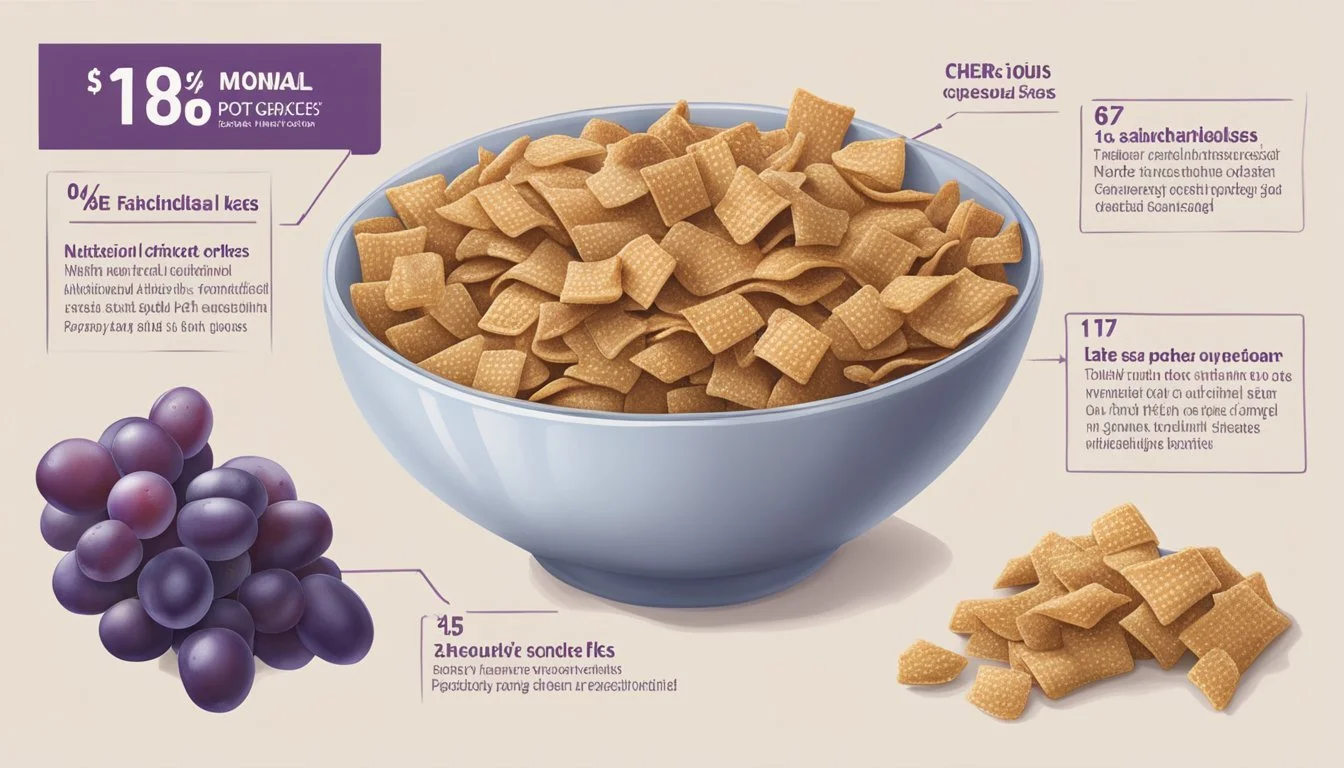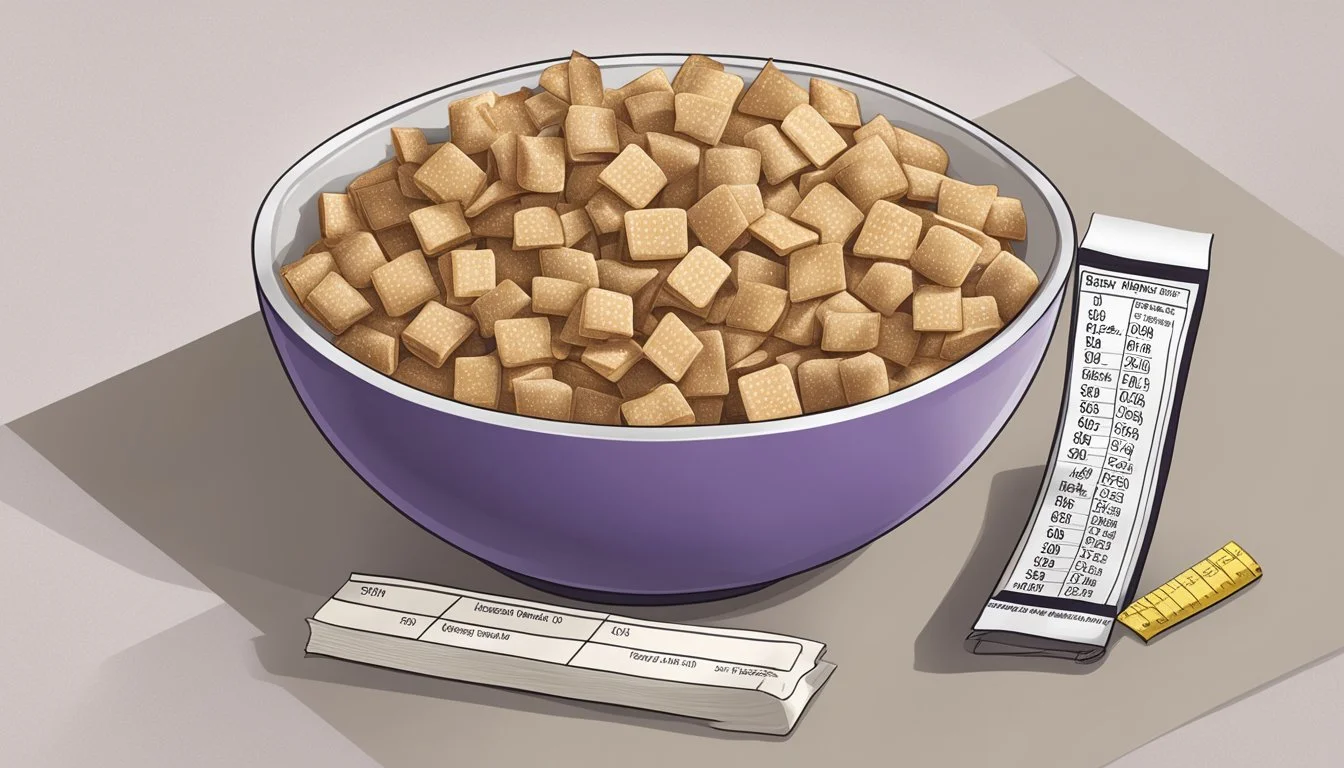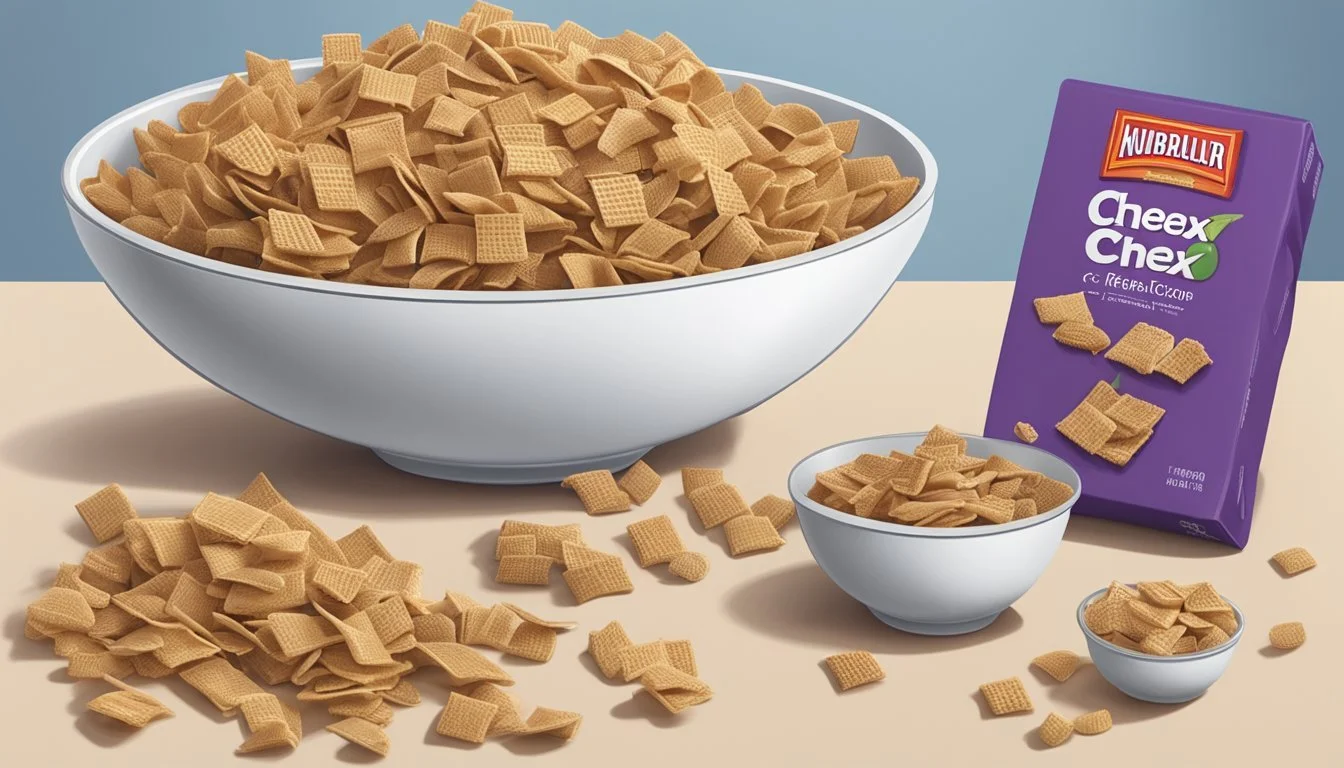Chex vs Post GrapevsNut Flakes
Detailed Comparison and Best Choice
This Article is Part of Our Breakfast Cereal Guide with Details on Chex Nutrition and Post GrapevsNut Flakes Nutrition
For those looking to make healthier choices at breakfast, comparing Chex and Post Grape-Nuts Flakes is essential. Chex cereals, particularly Corn Chex, are known for their light texture and straightforward ingredients, making them a popular choice for families. Post Grape-Nuts Flakes, on the other hand, offer a heartier option with their robust whole grain profile.
When examining the nutritional profiles, Grape-Nuts Flakes take the lead with higher fiber content, which is beneficial for digestive health and helps in maintaining a feeling of fullness longer. Chex, while lower in fiber, generally has a lighter and crispier texture that many find appealing. This cereal also tends to stay crunchy in milk, adding to its enjoyable eating experience.
In terms of versatility, Chex can be used in a variety of recipes beyond just breakfast, like snack mixes and bars. Post Grape-Nuts Flakes, with their nutty flavor and crunchy texture, are ideal for those who enjoy a substantial, filling breakfast. Thus, the choice between Chex and Grape-Nuts Flakes often comes down to individual nutritional needs and taste preferences.
Historical Background
Both Chex and Grape-Nuts Flakes have rich histories that reflect their development and evolution over the years. Chex originated under General Mills, while Grape-Nuts and its Flakes variant were introduced by Post.
Origins of Chex
Chex was introduced by General Mills during the mid-20th century. Initially, it was known for its unique square shape and crisp texture.
The first variety, Wheat Chex, was launched in 1937. Corn Chex followed in 1958, and Rice Chex appeared shortly after.
General Mills aimed at producing cereals that could be versatile, used not just for breakfast but also in recipes, most notably in the popular "Chex Mix" snack. This versatility made Chex a household name in American culture.
Rise of Grape-Nuts and Grape-Nuts Flakes
Grape-Nuts, created by Post, debuted in 1897. Despite its name, it contains neither grapes nor nuts, but rather, wheat and barley.
The cereal was marketed for its crunchy texture and high nutritional value. Grape-Nuts Flakes, introduced later, offered a flakier alternative while maintaining the original's nutritional benefits.
Both Grape-Nuts and Grape-Nuts Flakes gained popularity due to their wholesome ingredients and were advertised as "the perfect food." The enduring legacy of these cereals is seen in their sustained presence on grocery shelves for over a century. This speaks to their lasting appeal and consumer trust.
Nutritional Profiles
Comparing Chex and Post Grape-Nuts Flakes reveals important differences in their nutritional makeups. These differences can guide healthier breakfast choices based on individual dietary needs.
Macronutrients and Calories
Chex: Chex traditionally provides around 120 calories per serving (1 cup or 30 grams). It contains 1 gram of fat, 24 grams of carbohydrates, and 3 grams of protein. The exact nutritional profile may vary by flavor, such as Rice Chex, Corn Chex, or Wheat Chex.
Post Grape-Nuts Flakes: Post Grape-Nuts Flakes offer 110 calories per serving (1 cup or 29 grams). They contain 0.5 grams of fat, 24 grams of carbohydrates, and 2 grams of protein.
Nutrient Chex (per serving) Grape-Nuts Flakes (per serving) Calories 120 110 Fat (grams) 1 0.5 Carbohydrates (grams) 24 24 Protein (grams) 3 2
Vitamins and Minerals Content
Chex: Chex cereals often fortify their products with vitamins and minerals. A typical serving provides significant percentages of daily recommended values: 50% Vitamin B6, 25% Vitamin D, 25% Calcium, and 25% Iron. Such fortification aims to support overall nutrient intake.
Post Grape-Nuts Flakes: Similarly, Post Grape-Nuts Flakes are fortified with essential nutrients. A serving typically contains 20% of the daily value for Iron, 10% for Calcium, and 30% for several B vitamins. This fortification makes them a robust option for meeting micronutrient needs in a balanced diet.
Comparative Fiber Analysis
Chex: Fiber content in Chex varies slightly depending on the type. For instance, Wheat Chex offers higher fiber—up to 8 grams per serving—while Corn or Rice Chex might provide around 2 grams per serving.
Post Grape-Nuts Flakes: Post Grape-Nuts Flakes generally offer about 3 grams of fiber per serving. The fiber content helps in aiding digestion and maintaining a healthy gut.
Fiber Content Chex (per serving) Grape-Nuts Flakes (per serving) Grams of Fiber Up to 8 (varies) 3
Both brands hold distinct nutritional merits. Chex excels in fortification with essential vitamins and minerals, whereas Post Grape-Nuts Flakes offer a consistent amount of fiber, supporting dietary balance and digestive health.
Health Considerations
When comparing Chex to Post Grape-Nuts Flakes, several health factors emerge as critical. These include impacts on blood sugar regulation and the role of each cereal in weight management.
Impact on Blood Sugar Regulation
Both Chex and Post Grape-Nuts Flakes influence blood sugar levels differently due to their ingredients and nutritional profiles. Chex, particularly Corn Chex, contains whole grains which provide moderate amounts of dietary fiber. This helps in slowing the absorption of sugar into the bloodstream, beneficial for people managing type 2 diabetes.
Post Grape-Nuts Flakes, also made from whole grains, offer a higher fiber content which can be more effective in regulating blood sugar levels. The fiber in these flakes promotes slower digestion and a gradual rise in blood glucose levels, reducing the risk of sudden spikes.
Unlike sugary cereals, these two options offer more stable blood sugar levels post-consumption. Incorporating such cereals into a diet can be a strategic move for those looking to manage their glycemic index more effectively.
Cereal's Role in Weight Management
The role of these cereals in weight management hinges on their calorie content, fiber levels, and nutrient density. Chex, with its lower calorie count, can be a suitable option for individuals focusing on calorie control without sacrificing nutritional value.
On the other hand, Grape-Nuts Flakes, with their higher fiber content, provide prolonged satiety which can aid in reducing overall calorie intake throughout the day. Fiber-rich foods are known for their ability to maintain a sense of fullness, crucial for weight management.
Both cereals avoid the pitfalls of grain-free, low-fiber diets, providing essential nutrients that support a healthy metabolism. Opting for these nutrient-packed cereals over sugary options can contribute to better weight control strategies.
Taste and Texture Analysis
Chex and Post Grape-Nuts Flakes both offer distinct experiences in flavor and texture, influencing their suitability for various taste preferences and dietary needs.
Flavor Profiles
Chex features a straightforward, mild corn flavor with a subtle sweetness, making it versatile for both sweet and savory applications. When paired with milk, it retains its slightly sweet profile, enhanced by the milk's creaminess.
Post Grape-Nuts Flakes, on the other hand, boast a more complex flavor profile. The flakes carry a sweet malt taste that becomes more pronounced when soaked in milk. This cereal also has a roasted nut aftertaste that can appeal to those who prefer a heartier, richer cereal experience.
Texture Comparisons
Chex offers a light, airy texture with each bite, providing a satisfying crunch that remains fairly stable in milk. The cereal pieces typically soften slowly, allowing for a consistent crunchiness throughout the bowl.
In contrast, Post Grape-Nuts Flakes have a denser texture that can lead to "mouth fatigue" when consumed in large quantities. These flakes become slightly softer when soaked in milk, but their robust structure ensures they do not turn mushy quickly. The texture can be particularly enjoyable for those who appreciate a more substantial bite in their cereal.
By analyzing flavor and texture, consumers can better determine which cereal aligns with their preferences for breakfast satisfaction.
Consumer Experience
The consumer experience of eating Chex and Post Grape-Nuts Flakes can vary greatly based on how they are paired or used in different recipes, as well as the recommended serving sizes and consumption tips.
Cereal Pairings and Recipes
Chex and Post Grape-Nuts Flakes can be used beyond just a morning bowl of cereal. Chex can be used in snack mixes, adding a crunch to oatmeal, or even in baking recipes such as cookies and bars.
Grape-Nuts Flakes, due to their lighter texture, work well in yogurt parfaits or mixed with other cereals. Both cereals can be combined with fruits, nuts, or honey to enhance flavor and nutritional value.
For a quick recipe, Chex can be mixed with peanut butter, chocolate, and powdered sugar to create a sweet, crunchy treat known as 'Muddy Buddies.' Grape-Nuts Flakes can be used in place of oats in some baking recipes, adding a different texture and adding complexity to the dish.
Serving Size and Consumption Tips
Understanding proper serving sizes can help manage calorie and sugar intake. A typical serving size for Chex is around 1 cup, which weighs about 1 ounce. It's crucial to measure portion sizes to avoid overeating, especially with cereals that are low in sugar but high in carbohydrates.
For Grape-Nuts Flakes, a serving size is often ¾ cup or about 1 ounce. Since Grape-Nuts Flakes are nutrient-dense, they can be more filling, making it easier to stick to smaller portions.
Both cereals can be combined with other healthy ingredients like fresh fruits, yogurt, or a small amount of honey to balance taste and nutrition, keeping the breakfast both enjoyable and nutritious.
Brand Comparisons
Chex and Grape-Nuts Flakes offer distinct approaches in the cereal market. Exploring their market positioning, variety, and advertising strategies provides insight into their consumer appeal.
Market Position and Popularity
General Mills is the manufacturer behind Chex, with Corn Chex being one of the popular variants. Chex has carved out a significant niche, known for being a versatile cereal used in recipes beyond breakfast.
Post Grape-Nuts Flakes by Post Consumer Brands maintains a steady presence, appealing to those seeking less processed and densely nutritious options. Understanding these market positions helps gauge their popularity and consumer loyalty.
Variety and Product Range
The Chex brand boasts an array of flavors and types, including Rice Chex, Corn Chex, and Wheat Chex. Their gluten-free options like Corn Chex and Rice Chex cater to specific dietary needs, broadening their market appeal.
Grape-Nuts Flakes does not offer as broad a range but focuses on providing a classic, whole grain cereal option. This limited variety helps Post maintain a clear and consistent brand image, appealing to consumers looking for simplicity and health benefits.
Advertising and Brand Image
Chex's advertising is dynamic, leveraging various media channels and seasonal recipes to engage consumers. This approach highlights the cereal's versatility, making it a familiar household name.
Post Grape-Nuts Flakes, in contrast, often emphasizes the cereal's nutritional benefits and heritage. Their campaigns focus on the product's simple ingredients and long-standing presence in the market, appealing to health-conscious consumers.
Both brands use targeted strategies to build their identities, with Chex focusing on versatility and variety, while Grape-Nuts Flakes emphasizes health and tradition.
Dietary Considerations
Choose carefully between Chex and Post Grape-Nuts Flakes based on dietary needs. Key considerations include gluten content, sugar levels, and potential alternatives for restrictive diets.
Gluten-Free Options
Chex offers several gluten-free varieties, making it suitable for those with gluten intolerance or celiac disease. The labeling on the box confirms its gluten-free status.
Post Grape-Nuts Flakes, contains wheat, making it unsuitable for a gluten-free diet.
For those needing gluten-free options, Chex provides a clear advantage. Varieties like Rice Chex or Corn Chex are popular and widely available.
Sugar Content and Alternatives
Chex is relatively low in sugar compared to many cereals. For example, Corn Chex contains 3 grams of sugar per serving. Sweeteners include sugar, molasses, and salt.
Post Grape-Nuts Flakes has about 5 grams of sugar per serving. The sugar content is slightly higher, but it also tends to provide a robust flavor.
Alternative sweeteners like honey or fruit toppings can enhance flavor while maintaining health benefits.
Cereal Alternatives for Special Diets
For low-sodium diets, Chex varieties offer options with minimal salt content. Corn Chex is a great choice, with 300 mg of sodium per serving.
For high-fiber diets, Grape-Nuts Flakes shine with 3 grams of dietary fiber per serving. Their high fiber content aids digestion.
Those on a low-carb diet might consider options like nut-based cereals which lower carbohydrate intake while providing essential nutrients.
Conclusively, dietary considerations for choosing between these cereals hinge on gluten content, sugar levels, and specific diet requirements.
Environmental and Ethical Aspects
When comparing Chex and Post Grape-Nuts Flakes, it's essential to consider their environmental impacts and ethical commitments. Addressing these aspects can provide consumers with data to make more informed choices.
Sustainable Practices
Chex has made efforts towards sustainability by using more environmentally friendly packaging and reducing waste during production. Their parent company, General Mills, is committed to cutting greenhouse gas emissions and implementing renewable energy solutions.
Post, the maker of Grape-Nuts Flakes, has similar initiatives. They emphasize sourcing ingredients responsibly and minimizing their carbon footprint. Both companies have invested in sustainable agricultural practices, aiming to use fewer chemicals and more eco-friendly farming techniques.
Corporate Responsibility
Chex's parent company, General Mills, has a strong stance on corporate responsibility. They aim for transparency in their supply chain and uphold ethical labor practices. General Mills also engages in community support and philanthropy, aiding in educational programs and hunger relief.
Post Holdings, responsible for Grape-Nuts Flakes, also underlines corporate ethics. They are proactive in supporting local communities and ensuring safe, fair working conditions for their employees. Employee welfare and ethical labor sourcing are prioritized to uphold their corporate integrity.
By understanding these elements, consumers can better appreciate the ethical responsibilities and environmental considerations of their cereal choices.
More on Chex
More on Post GrapevsNut Flakes
Cinnamon Toast Crunch vs Post GrapevsNut Flakes: Which is better?
French Toast Crunch vs Post GrapevsNut Flakes: Which is better?
Honey Nut Cheerios vs Post GrapevsNut Flakes: Which is better?
Kellogg's Apple Jacks vs Post GrapevsNut Flakes: Which is better?
Kellogg's Froot Loops vs Post GrapevsNut Flakes: Which is better?
Post GrapevsNut Flakes vs Post Raisin Bran Cereal: Which is better?










